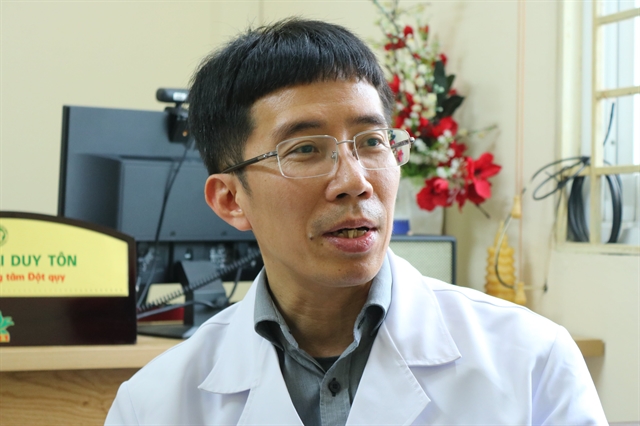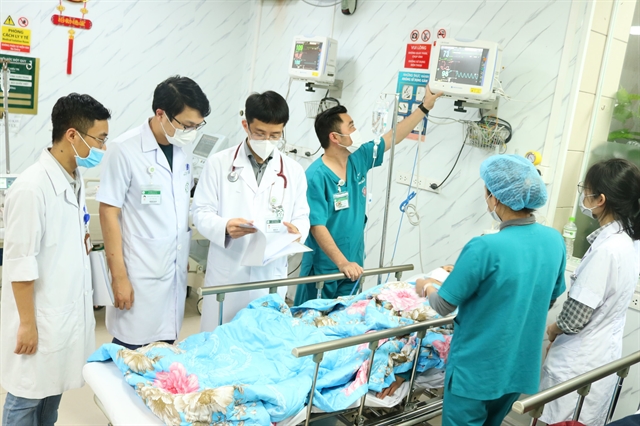 Society
Society


|
| Associate Professor Mai Duy Tôn.— Photo nhandan.vn |
Associate Professor, Mai Duy Tôn, director of the Stroke Centre at Bạch Mai Hospital, was nominated by the World Stroke Organisation as an excellent individual for his great contributions to Việt Nam and the world. He talked to Nhân dân (People) online newspaper about his career and his efforts to take care of people's health in Việt Nam.
You are known for being the first person to deploy thrombolytic therapy for stroke patients at Bạch Mai Hospital. Why did you choose this specific field of medicine?
When I was officially accepted to work at A9 Emergency Centre at the hospital, young doctors like me always have the desire to contribute. In 2007, the hospital sent me to study at the Mayo Clinic in the United States (US). Their medicine there was too advanced, beyond my imagination. Therefore, I decided to choose a field that can be applied in Việt Nam that brings spectacular changes to patients. I chose to learn about the treatment of brain strokes.
At that time, Bạch Mai Hospital was the frontline in emergency care, but saving a stroke patient's life was very challenging. The chance of survival was slim. If the patient was saved, he or she still might be disabled for life.
In the US, stroke patients after receiving emergency care and good treatment, show little sequelae. In the US, they apply many specialised techniques, helping to improve treatment outcomes and patients' quality of life. Only in a short time, stroke patients can return to normal activities. The spectacular changes made me determined to pursue learning the techniques. Then, I asked the head of the A9 emergency centre let me to continue studying in-depth about strokes.
In 2014, I applied for a scholarship funded by the European Stroke Organisation to study a master's degree. Then I came to Austria to study. I saw that the stroke treatment in Austria was developed on par with the US, and the most specialised techniques were applied. With the support of the Board of Directors of the hospital and A9 emergency centre, the Stroke Unit, under the centre, was established, specialising in the treatment of acute stroke patients and applying specialised techniques.
Since then, thrombolytic therapy has been applied to stroke patients and brought spectacular results. Many patients were treated quickly, after one hour of using the medicine, they recovered completely, spoke and took part in normal activities. They were able to leave the hospital after two or three days.
How has the knowledge you learned been applied in Việt Nam to be both suitable for the Vietnamese people’s physical conditions and financial capability?
I have applied the techniques that I learned in the US in the most suitable way for the Vietnamese people’s physical conditions and financial capability.
In some European countries and the US, they apply thrombolytic therapy with a high dose, but in Việt Nam, I found that applying with the high dose can even increase the cost of treatment, so, I choose to use the therapy with a lower dose but still achieve the same effect and reduce the bleeding rate.
Giving first aid to stroke patients must coordinate with many specialities, especially it needs image analysis to apply the latest electro-optical techniques in diagnosis and treatment of thrombus removal for patients with large embolism, vascular intervention for patients with ruptured aneurysm. It is also necessary to work with the neurosurgery department to handle cases requiring surgery to remove haematomas, aneurysm clamp, and open craniotomy for large cerebral infarction. The coordination has become routine at the hospital. At the same time, stroke patients are also trained in early rehabilitation to recover and limit sequelae.

|
| Mai Duy Tôn (centre) examines a stroke patient in the hospital's Stroke Centre.— Photo nhandan.vn |
In just 14 years, you and your team have become a "fulcrum" for grassroots doctors and stroke patients. What will you do to contribute to Việt Nam's stroke specialty?
Previously, the recovery rate in stroke patients was only 25 per cent, 25 per cent of stroke patients will die and 50 per cent will face disabling sequelae. However, when applying new techniques, like in developing countries, over 50 per cent of stroke patients, who are saved during the golden hour, return to normal. Thanks to the expertise in treatment methods at stroke treatment units, the rate of fatal complications and disabling sequelae in stroke patients, who were taken to the treatment units late, has been greatly reduced. Many stroke patients, who are treated in combination with intensive resuscitation and early rehabilitation exercises, recover better than before. As a result, stroke treatment at the hospital is increasingly making progress with regional-level techniques.
On November 9, 2020, the hospital established the Stroke Centre, developed from the Stroke Unit. In less than two years, the centre has made contributions to not only the hospital but also the stroke specialty nation-wide. Every year, the centre has treated a large number of stroke patients in the north. The most intensive techniques are deployed by the hospital in collaboration with relevant centres in the hospital, bringing the best treatment results to patients. The stroke centre is also believed to be a reliable address for foreign patients living and working in Việt Nam.
The stroke centre has contributed many research work on strokes in Việt Nam to the world. We regularly run scientific reports every two weeks and distribute them for free on Zoom for colleagues across the country to update their in-depth knowledge about stroke.
What keeps you staying in the medical sector, especially in this most difficult emergency area?
Perhaps the memory that my grandfather, who lived in the rural area, was often sick, and it was very difficult to find a doctor visit and examine for him, made me think that I have to take responsibility for taking care of my family's health. I studied very hard and passed the university entrance exam of Hà Nội Medical University. I studied to become a resident doctor specialising in emergency resuscitation. My classmates and I challenged each other to see who can work at Bạch Mai Hospital after graduation.
Then, I found that learning to become a doctor is too hard. The time I learned at the university was also the time that Severe acute respiratory syndrome (SARS) outbreaks hit the country. The medical facilities were poor, the medical equipment were not available and the danger was lurking. That was also the time when I wanted to quit the study.
But my teachers including Vũ Văn Đính, Nguyễn Thị Dụ, Nguyễn Đạt Anh, Đặng Quốc Tuấn and Nguyễn Văn Chi already gave me great motivation to stay with the career. After finishing my studies, I was accepted to work at Bạch Mai Hospital. At that time, I was extremely proud, not only because I won the challenge of my friends but also because I overcame myself and I believed that the medical career is really my destiny.
Looking back on the journey of learning, bringing stroke-treatment techniques to Việt Nam and being a contributor to replicate stroke centres across the country, what have you achieved?
I feel I have chosen the right path. I am proud that I have laid the foundation for the hospital’s stroke centre, laid the foundation for the birth of the first subject of stroke and cerebrovascular disease in Việt Nam at the University of Medicine and Pharmacy under the Việt Nam National University, Hà Nội.
I am also the person who connects doctors of stroke centres across the country to participate in researching stroke-treatment projects with large research data, which can be published internationally.
The hospital’s stroke centre has never refused any stroke patient. During the COVID-19 pandemic, there were cases of critical strokes and large embolic cerebral infarction, transferred from Hải Dương Province to the hospital, we still received the patients even though there were no family members to sign the commitment and pay the hospital fees.
For me, the biggest achievement is the recovery of stroke patients, the high rate of patients surviving and recovering from a stroke, the generation of young doctors who are willing to work to save their stroke patients, the grassroots level doctors always exchange professional skills to get the best quality of stroke-treatment for patients.
The biggest achievement is also the belief from hospital leaders and medical experts from major stroke centres around the world, who are always ready to help and encourage me to continue on this path. — VNS